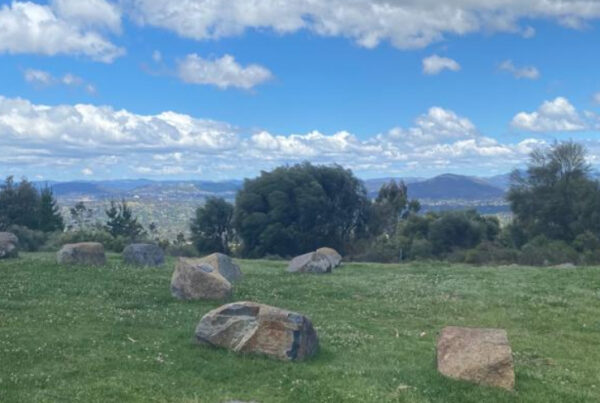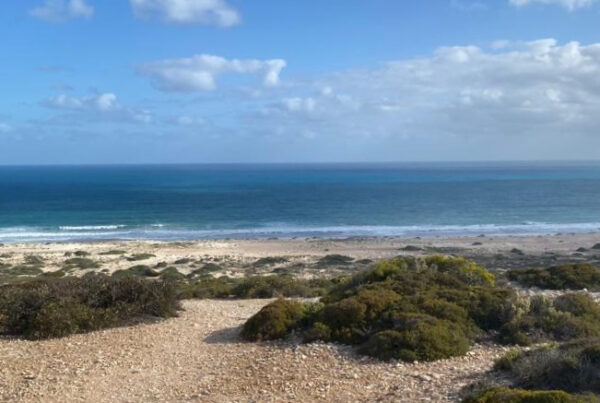When the coronavirus pandemic necessitated global travel restrictions, the consequent postponement of Charge Around Australia turned months of planning the project into years. So we were absolutely delighted for our epic Charge Around Australia drive to finally begin on 2 September.

Thank you to everyone who joined the launch of the CAA expedition in Newcastle, New South Wales on 2 September. Special thanks go to the University of Newcastle, Australia, and the Centre for Organic Electronics, Edea Energy, Bardan Cells, Kardinia Energy, Tesla Owners of Australia, and Tiny Science Lab who have all helped make this trip possible.
Let’s go!
ABC News provided welcome coverage as the first weekend saw the drive team of Project Director Stuart McBain and support vehicle driver Dr Thilo Kober, in the Tesla 3 electric vehicle and Mercedes van respectively, head north from Newcastle. They drove, through heavy rain, more than 600km up the coast to Byron Bay via Port Macquarie and Coffs Harbour.
On arriving in Byron Bay, the rain had stopped so the solar sheets were rolled out and plenty of energy was harvested and saved in the batteries in the trailer before being transferred across to the car.
Part of the process of rolling out the solar sheets to gather energy from the sun includes deciding whether the wind conditions are going to be high or low. If it’s the former, then the entire sholar sheet is pinned down the whole way round, while for the latter, only half of the sheet is pinned down, as on this occasion. Unexpectedly strong gusts of wind resulted in one of the sheets getting torn. It was sent back to the University of Newcastle to be repaired. A minor setback, but after all the project is about testing the solar sheets in the real world.

On day 5, Stuart and Thilo travelled from Byron Bay up to Brisbane, stopping in at the Numinbah Valley Environmental Education Centre en route. They also managed to successfully transfer the electricity gathered the previous day into the Tesla. This first field charge of the car from the solar sheets went well, charging at 21km an hour at the full 15 amps. The next step is to set up solar energy harvesting and car charging at the same time.
Charge Around Roadshow
Day 6 of the challenge saw the drive team meet the students from Alexandra Hills State High School. The CAA roadshow featured the project introduction, followed by interactive science experiments and computer games to raise awareness of the importance of renewable energy sources.
The drive team were able to gather charge into the battery which would normally go into the inverter and be converted into the 230 volts necessary to charge the car. However, it turned out that the batteries weren’t discharging as expected, so they were sent off for further testing and recharging as Stuart and Thilo headed further north up to the Sunshine Coast.
Day 7, and the pupils at Mountain Creek State High in Maroochydore were engaged and interested in the project and asking some insightful questions about the drive, solar power and climate change. The difficult decision was taken to stop allowing kids on school visits to jump about inside the car, precipitated by the fact that one of them here opened the boot and when closing it a little overenthusiastically, accidentally bent the boot bracket. A Tesla no entry policy from now on for the school kids! The Tesla dance and car summons will have to do for car-related entertainment in future, as Stuart and Thilo aim to travel around the rest of the country without sustaining further damage to the car.
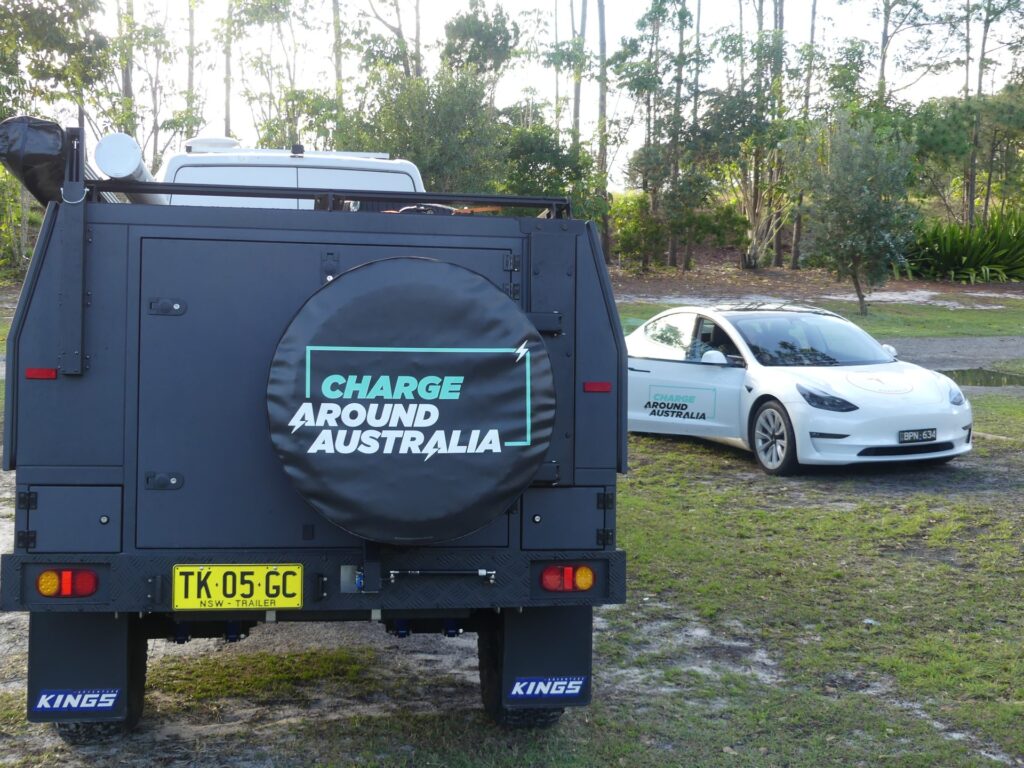
Day 8 and a visit to Gympie South State School in Gympie, Queensland was greatly helped by the friendly and inspirational teachers who made sure the team had everything they needed to deliver another rewarding roadshow to the pupils.
Day 9, a Saturday, was spent in Bundaberg at St Luke’s Anglican School where an informal open day was attended by a small but enthusiastic gathering of locals who were interested in the technology – the solar sheets – the car and the entire project and were well informed about the aims of Charge Around Australia challenge, which was hugely gratifying. Unfortunately, another solar sheet was torn by an unexpected strong gust of wind when pinned out for charging. But despite this setback spirits remained high.
We acknowledge the Traditional Custodians of the land on which we work and live, the Taribelang Bunda of the Kabi Kabination, and pay respects to the Gooreng Gooreng people, who have a strong connection to this land upon which we meet.
Day 10 was a well-earned rest day for the drive team, who by now were operating very well together. The Tesla 3 had performed admirably, and the pupils at the schools visited had been enthusiastic and interested in the project, supported by their incredibly helpful teachers.
When weather allowed, the solar sheets had been rolled out and successfully harvested solar energy as expected. Here’s to the next 10 days!
Day 11, Monday and the CAA drive team rolled into Rockhampton, Queensland and were able to lay out the solar charging set up in Rockhampton State High School in a reasonably tight space, but in dry conditions with very little wind. For the first time, the roadshow featured the Tiny Science Lab electric car kits that pupils were able to build and race making a super fun activity for a number of groups.
We acknowledge the Traditional Custodians of the land on which we work and live, and pay respects to the Darumbal People.
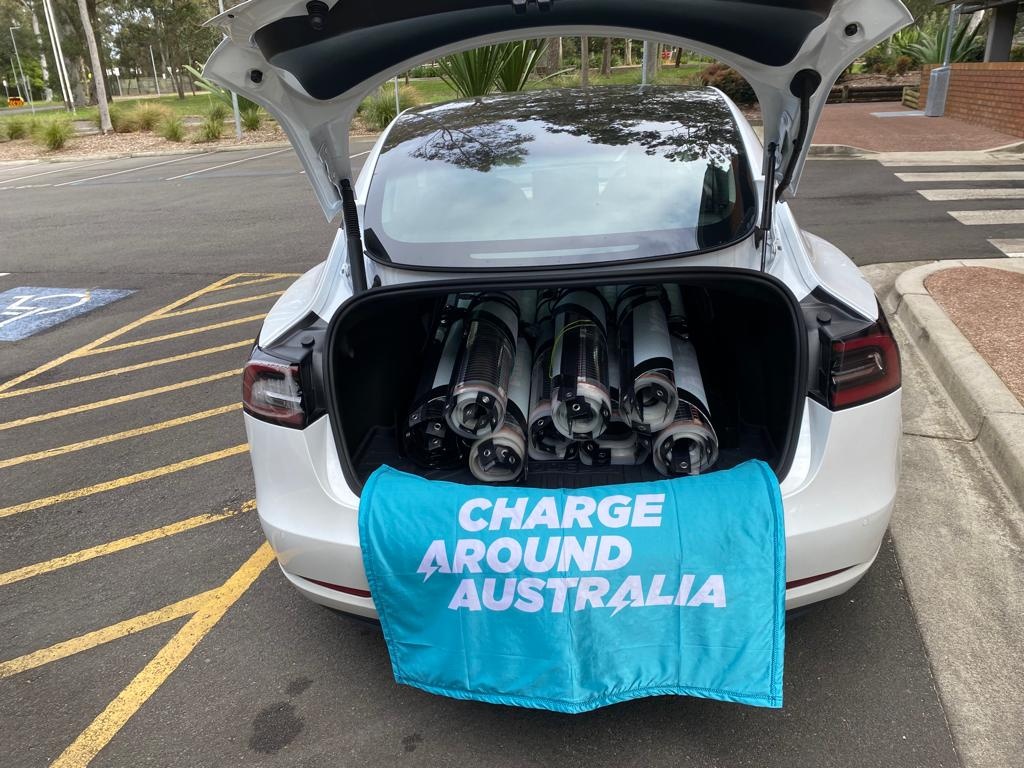
Day 12. A four-hour drive up Highway 1 brought the team to the town of Walkerston, in Mackay, Queensland where the pupils at Walkerston State School enjoyed two rewarding sessions with Stuart showcasing the project’s aims and the importance of using renewable energy sources.
Day 13 and another two hour’s drive north saw the team arrive in Bowen, where Queens Beach State School hosted, allowing the solar sheets to be rolled out for the entire sunny day harvesting solar energy. Multiple roadshow sessions included the live link with Paul Dastoor and the University of Newcastle team, as well as solar panel making workshops.
We pay respect to the Birri, Jangga, Juru, Gia, and Ngaro peoples, who have a strong connection to this land upon which we meet.
Day 14. The final stretch heading north up the coast finished at Townsville, where the team headed to Willows State School. Roadshow sessions were well received by several class groups before the drive headed inland for the relatively short hop to the rural Queensland town of Charters Towers.
We acknowledge the Wulgurukaba of Gurambilbarra and Yunbenun, Bindal, Gugu Badhun and Nywaigi as theTraditional Owners of this land.
Go west
Day 15. At Columba Catholic College it was the last day of term before holidays, so there was an upbeat atmosphere during the roadshow interactive science experiments and computer games with the engaged Years 11 and 12 students.
It had started to get much hotter with clear skies and temperatures around 32 degrees Celsius, so good conditions for harvesting solar energy, although the trailer battery cooling system kicked in due to the high temperature, using up some of the gathered energy.
Day 16 saw the team backtrack a little to Townsville en route to enjoy a day off exploring the mountainous terrain and sandy beaches of Magnetic Island National Park, home to abundant wildlife from bats to wombats.
Day 17. The drive team had headed west as far as the tiny town of Prairie, in Outback Queensland, which is so small that the school only has seven pupils, three of whom are siblings. But fortunately it is also home to the Prairie Hotel where the team were welcomed to stay on the campground.
We acknowledge Traditional Custodians of the land on which we work and live, the Kalkadoon people who followed patterns of hunting and gathering, fishing and trade for many thousands of years before the arrival of the first Europeans.
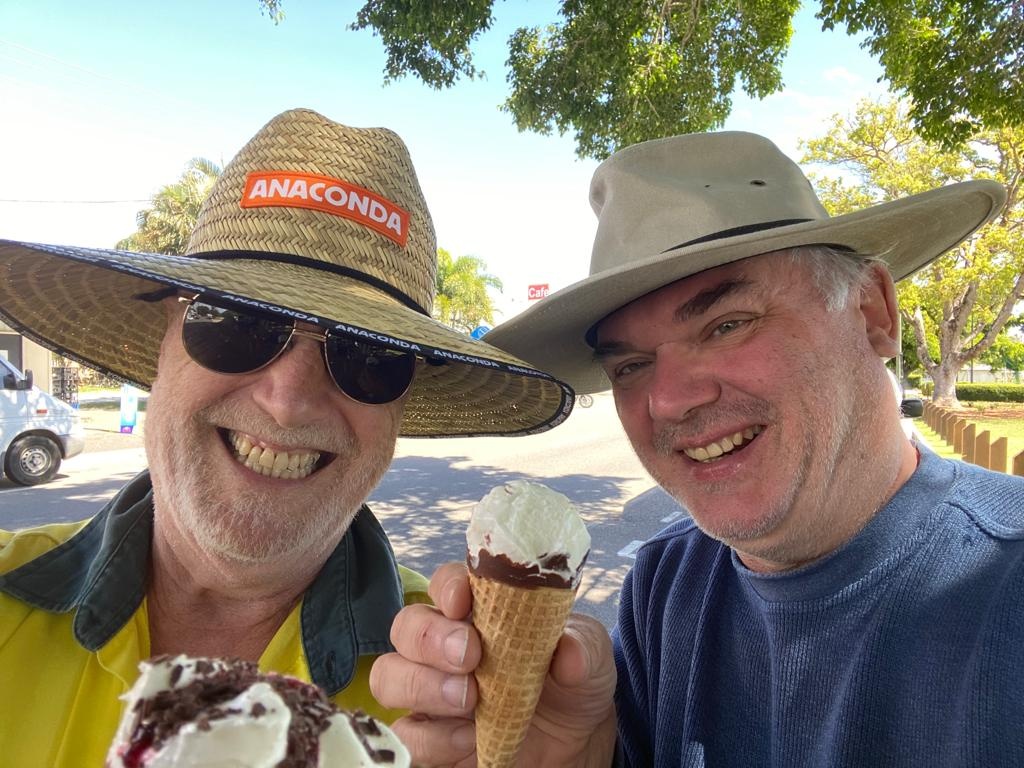
Day 18. The team stopped off at Hughenden to charge the EV at the first non-Tesla charging station on the journey, en route to the small town of Richmond. Here they stayed on land next to the Kronosaurus Korner dinosaur museum, and tried to get used to the heat: 40 degrees Celsius by day and 34 degrees at night, as well as prepare themselves for the forthcoming stretches through very isolated areas. With a peak daytime temperature of 44 degrees, Stuart had to turn on the AC in the Tesla when driving, which of course requires energy to power it.
Day 19 and the team were in Julia Creek where a storm was forecast so they didn’t roll out the solar sheets for charging. Another storm was forecast for the following day at Cloncurry, so again no roll out. This town was formerly the home of John Flynn, who in 1928 pioneered the Royal Flying Doctor Service that continues to provide people living in very remote areas of Australia with healthcare access. The John Flynn Place museum honours Flynn’s vision that transformed life in the Australian outback.
We acknowledge the Traditional Custodians of the land, and pay respects to the Wunumara, Mitakoodi, Kalkadoon and Pitta Pitta Aboriginal people for whom the area was home prior to the arrival of Europeans.
Day 21 saw the team enjoy a day at the Outback at Isa centre in Mount Isa, that details the development and history of this mining town across a number of museum exhibitions and tours. The mayor of the town came to meet Stuart and Thilo to hear about the project, and ABC Northwest Radio carried out an interview.
Three weeks into the journey and morale remained high, with the drive team looking forward to moving on through Queensland and into the Northern Territory.


